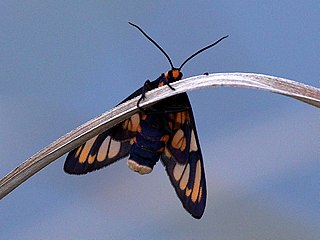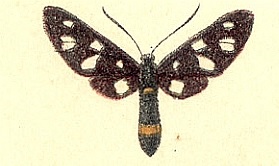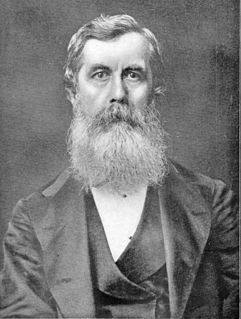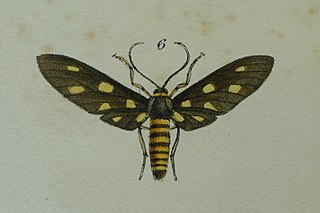
Spilomelinae is a very species-rich subfamily of the lepidopteran family Crambidae, the crambid snout moths. With 4,132 described species in 340 genera worldwide, it is the most speciose group among pyraloids.

The nine-spotted moth or yellow belted burnet is a moth in the family Erebidae. The species was first described by Carl Linnaeus in his 1758 10th edition of Systema Naturae.

Amata is a genus of tiger moths in the family Erebidae. The genus was erected by Johan Christian Fabricius in 1807.

Amata huebneri, the wasp moth, is a moth in the genus Amata of the family Erebidae. The species was first described by Jean Baptiste Boisduval in 1829. It is found from the Indo Australian tropics to northern Australia.
Amata lampetis is a species of moth of the family Erebidae first described by Alfred Jefferis Turner in 1898. It is found in Australia.

Amata kruegeri, or Ragusa's nine-spotted moth, is a moth of the family Erebidae. The species was first described by Emile Enrico Ragusa in 1904. It is found in southern and eastern Europe.

Amata nigricornis is a species of moth of the family Erebidae first described by Sergei Alphéraky in 1883. It is common in Ukraine and found in the southern part of European Russia, the Transcaucasus, Turkey and Iran.
Amata ragazzii is a species of moth of the family Erebidae first described by Emilio Turati in 1917. It is found in Italy.
Amata pyrocoma is a species of moth of the family Erebidae first described by Edward Meyrick in 1886. It is found in Australia.

Amata antitheta is a species of moth of the family Erebidae first described by Edward Meyrick in 1886. It is found in Queensland, Australia.

Amata cantori is a moth in the genus Amata of the subfamily Arctiinae. The species was first described by Frederic Moore in 1859. It is found on Peninsular Malaysia and Borneo.
Amata aperta is a species of moth of the family Erebidae first described by Francis Walker in 1865. It is found in Australia and New Guinea.

Amata caspia is a species of moth of the subfamily Arctiinae first described by Otto Staudinger in 1877. It is found in south-western Russia, the southern Ural Mountains, the Caucasus, Transcaspia, Kazakhstan and Turkey.
Amata chroma is a species of moth of the family Erebidae first described by Charles Swinhoe in 1892. It is found in Australia.

Amata polymita, the tiger-striped clearwing moth, is a moth of the family Erebidae. The species was first described by Carl Linnaeus in 1768. It is found in China and Vietnam.

Frederic Moore FZS was a British entomologist. He was also an illustrator and produced six volumes of Lepidoptera Indica and a catalogue of the birds in the collection of the East India Company.

Amata fortunei, the white-spotted moth, is a moth of the family Erebidae. The species was first described by d'Orza in 1869. It is found in Japan, South Korea and Taiwan.

Amata wallacei is a species of moth in the family Erebidae first described by Frederic Moore in 1859. It is found on Java, Sumatra, Peninsular Malaysia and Borneo.













